5.1 Factors that Control Slope Stability
Mass wasting, which is synonymous with “slope failure”, is the failure and down-slope movement of rock or unconsolidated materials in response to gravity. The term “landslide” is almost synonymous with mass wasting, but not quite because some people reserve “landslide” for relatively rapid slope failures, while others do not. Because of that ambiguity, we will avoid the use of “landslide” in this textbook. Instead, wherever possible, mass wasting events will be referred to by specific names that describe the type of material that failed and the type of motion that took place.
Mass wasting happens because the Earth’s surface is made up of sloped surfaces, and that has happened because tectonic processes have produced uplift. Erosion, driven by gravity, is the inevitable response to that uplift, and mass wasting is a type of erosion. Slope stability is ultimately determined by two factors: the angle of the slope, and the strength of the materials on it.
Figure 5.1.1 shows a block of rock situated on a rock slope. It is being pulled towards the earth’s centre (straight down) by gravity. We can split the vertical gravitational force into two components relative to the slope, one pushing the block down the slope (the shear force), and the other pushing it into the slope (the normal force). The shear force—which wants to push the block down the slope—has to overcome the strength of the connection between the block and the slope, which may be quite weak if the block has split away from the main body of rock, or may be very strong if the block is still a part of the rock. This is the shear strength, and in Figure 5.1.1a it is greater than the shear force, so the block should not move. In Figure 5.1.1b the slope is steeper and the shear force is approximately equal to the shear strength. The block may or may not move under these circumstances. In Figure 5.1.1c the slope is steeper still, so the shear force is considerably greater than the shear strength, and the block will very likely move.

As already noted, slopes are created by uplift. In areas with relatively recent uplift (most regions that have angular-looking mountains) slopes tend to be quite steep, and this is especially the case where glaciation has taken place because glaciers in mountainous terrain create steep-sided valleys. In areas without recent uplift (such as most of eastern North America), slopes are less steep because hundreds of millions of years of erosion (including mass wasting) has made them that way. However, as we’ll see, mass wasting can happen even on relatively gentle slopes.
The strength of the materials on slopes can vary widely. Solid rocks tend to be strong, but there is a very wide range of rock strength. If we consider just the strength of the rocks, and ignore issues like fracturing and layering, then most crystalline rocks—like granite, basalt or gneiss—are very strong, while some metamorphic rocks—like schist—are moderately strong. Sedimentary rocks have variable strength. Limestone is strong, some sandstone and conglomerate are moderately strong, while some types of sandstone and all mudstones are quite weak.
Fractures, metamorphic foliation or bedding can significantly reduce the strength of a body of rock, and, in the context of mass wasting, this is most critical if the planes of weakness are parallel to the slope (see Figure 5.0.1) and least critical if they are perpendicular to the slope. This is illustrated on Figure 5.1.2. At locations a and b the bedding is nearly perpendicular to the slope and the situation is relatively stable. At location d the bedding is nearly parallel to the slope and the situation is quite unstable. At location c the bedding is nearly horizontal, and the stability is intermediate between the other two extremes.

Internal variations in the compositions of rocks can significantly affect their strength. Schist, for example, may have layers that are rich in sheet silicates (mica or chlorite) and these will tend to be weaker than other layers. Some minerals tend to be more susceptible to weathering than others, and the weathered products are commonly quite weak. The side of Johnson Peak that failed in 1965 (Hope Slide) is made up of chlorite schist (metamorphosed sea-floor basalt) that has feldspar-bearing sills within it (they are evident within the inset area of Figure 5.0.1). The foliation and the sills are parallel to the steep slope. The schist was relatively weak to begin with, and the feldspar in the sills, which had been altered to clay, made it even weaker.
Unconsolidated sediments are generally weaker than sedimentary rocks because they are not cemented and, in most cases, have not been significantly compressed by overlying materials. Sand and silt tend to be particularly weak, clay is generally a little stronger (unless it is wet, see below), and sand mixed with clay can be stronger still. The deposits that make up the cliffs at Point Grey in Vancouver include sand, silt and clay overlain by sand. As shown on Figure 5.1.3 (left) the finer deposits are relatively strong (they maintain a steep slope), while the overlying sand is relatively weak, has maintained a shallower slope and has recently failed. Glacial till—typically a mixture of clay, silt, sand, gravel and larger clasts—that forms beneath tens to thousands of metres of glacial ice and is well compressed, can be as strong as some sedimentary rock (Figure 5.1.3 – right).
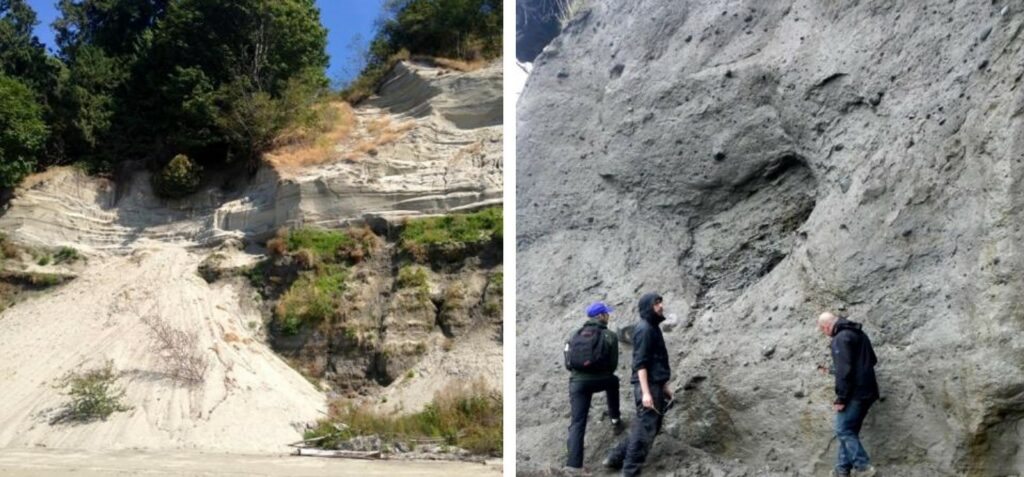
Apart from the type of material on a slope, the amount of water it contains is the most important factor controlling its strength. This is especially true for unconsolidated materials, like those shown on Figure 5.1.3, but it also applies to bodies of rock. Granular sediments, like the sand at Pt. Grey, have lots of spaces between the grains. Those spaces may be completely dry (filled only with air), or moist, (often meaning that some spaces are water filled, some grains have a film of water around them and small amounts of water are present where grains are touching each other), or completely saturated (Figure 5.1.4). Unconsolidated sediments tend to be strongest when they are moist because the small amounts of water at the grain boundaries hold the grains together with surface tension. Dry sediments adhere together only by the friction between grains, and if they are well sorted or well rounded, or both, that adhesion is weak. Saturated sediments tend to be the weakest of all because the large amount of water actually pushes the grains apart reducing the mount friction between grains. This is especially true if the water is under pressure.
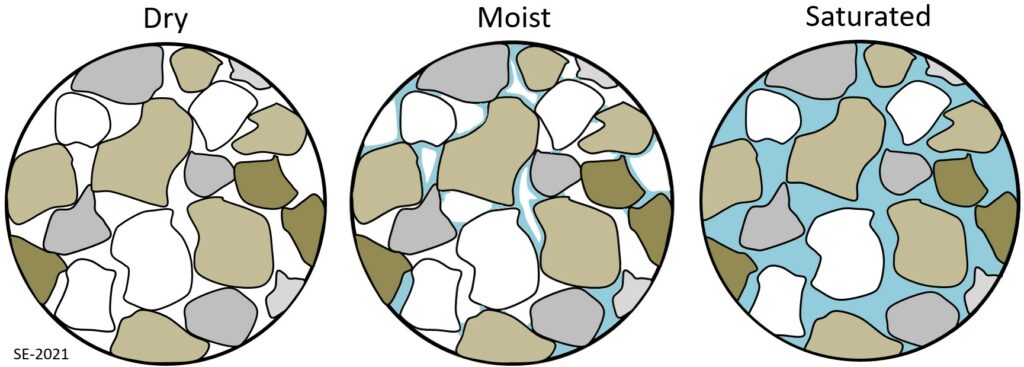
Exercise 5.1 Sand and Water
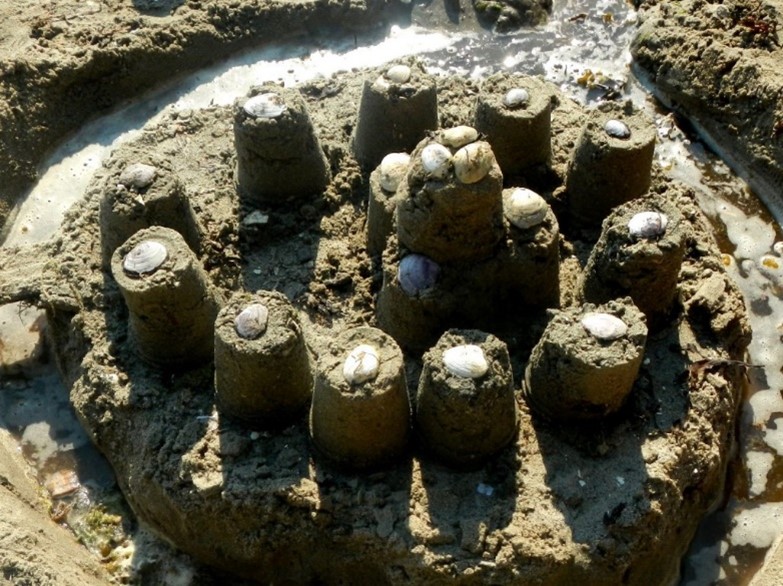
If you’ve ever been to the beach, you’ll already know that sand behaves differently when it’s dry than it does when it’s wet, but it’s worth taking a systematic look at the differences in its behaviour. Find about half a cup of clean dry sand (or get some wet sand and dry it out), and then pour it from your hand onto a piece of paper. You should be able to make a cone-shaped pile that has a slope of around 30˚. If you pour more sand on the pile it will get bigger, but the slope should remain the same. (This is known as the angle of repose, which is the steepest angle that a pile of dry sediment can maintain without failing.)
Now return the sand to a container and add some water so that it is moist. An easy way to do this is to make it completely wet and then let the water drain away for a minute. You should be able to form this moist sand into a steep pile (with slopes of around 80˚). Finally put the same sand into a container and fill it up with water so the sand is just covered. Swirl it around so that the sand remains in suspension, and then quickly tip it out onto a flat surface (best to do this outside). It should spread out over a wide area, forming a pile with a slope of only a few degrees.
Water will also reduce the strength of solid rock, especially if it has fractures or bedding planes, or clay-bearing zones. This effect is most significant when the water is under pressure, and that’s why you’ll often see holes drilled into rocks on road cuts. One of the hypotheses advanced to explain the 1965 Hope Slide is that the very cold conditions that winter caused small springs in the lower part of the slope to freeze over, preventing water from flowing out. It is possible that water pressure gradually built up within the slope, weakening the rock mass to the extent that the shear strength was no longer greater than the shear force.
Water also has a particular effect on clay-bearing materials. All clay minerals will absorb a little bit of water, and this reduces their strength. The smectite clays (such as the bentonite used in cat litter) can absorb a lot of water, and that water pushes the sheets apart on a molecular level and makes the mineral swell. Smectite that has expanded in this way has almost no strength; it is extremely slippery.
And finally, water can significantly increase the mass of the material on a slope. This will increase the gravitational force pushing it down, but it will also increase the normal force pushing mass against the slope and that will increase the friction, so while adding water may make the material on the slope weaker and more prone to fail, the additional weight doesn’t necessarily contribute to failure.
Mass-wasting triggers
In the foregoing discussion we talked about the shear force and the shear strength of materials on slopes, and about factors that can reduce the shear strength. Shear force is primarily related to slope angle, and this does not change quickly. But shear strength can change quickly for a variety of reasons, and events that lead to a rapid reduction in shear strength are considered to be triggers for mass wasting.
An increase in water content is the most common mass-wasting trigger because of the reduction in strength. This can result from rapid melting of snow or ice, by heavy rain, or by some type of event that changes the pattern of water flow on the surface. Rapid melting can be caused by a dramatic increase in temperature (e.g., in spring or early summer) or by a volcanic eruption. Changes in water flow patterns can be caused by earthquakes, or previous slope failures that dam up streams or human structures that interfere with runoff (e.g., building, roads or parking lots). An example of this is the deadly 2005 debris flow in North Vancouver (Figure 5.1.5). The 2005 failure took place in an area that had failed previously, and in a report written in 1980 it was recommended that steps be taken by the municipal authorities and the residents to address drainage issues. Little was done to improve the situation.[1]
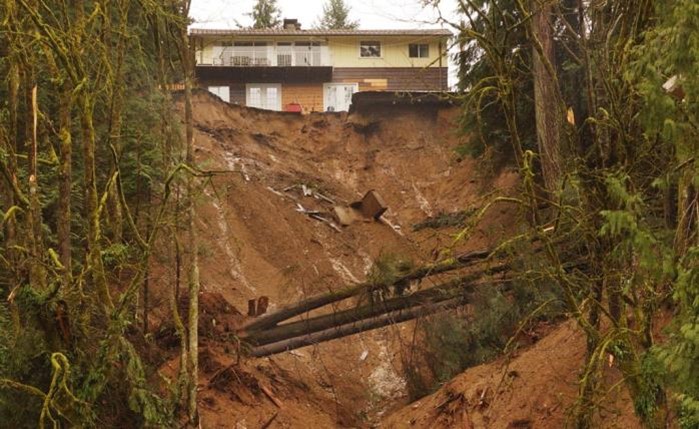
In some cases, a decrease in water content can lead to failure. This is most common with clean sand deposits (e.g., the upper layer in Figure 5.1.3, left), which lose strength when there is no more water around the grains.
Freezing and thawing can also trigger some forms of mass wasting, more specifically, the freezing can expand the crack between two parts of rock, and then thawing can release a block of rock that was attached to a slope by a film of ice, as illustrated on Figure 5.1.6.
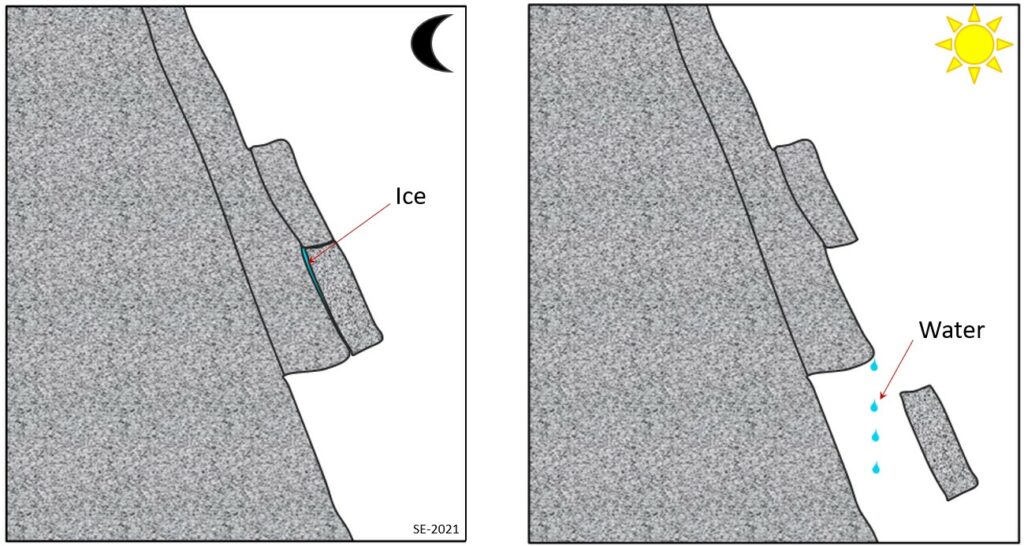
Shaking is another process that can weaken a body of rock or sediment. The most obvious source of shaking is an earthquake, but shaking from highway traffic, construction or mining will also do the job. Several deadly mass wasting events (including snow avalanches) were trigged by the M7.8 earthquake in Nepal in April 2015.
Saturation with water and then seismic shaking led to the occurrence of thousands of slope failures in the Sapporo area of Hokkaido, Japan in September 2018, as shown on Figure 5.1.7. The area was drenched with rain from tropical storm Jebi on September 4th, and then shaken by a M 6.6 earthquake on September 6th. That combination appears to have triggered thousands of debris flows of water-saturated volcanic materials on steep slopes. There were 41 deaths related to these slope failures.
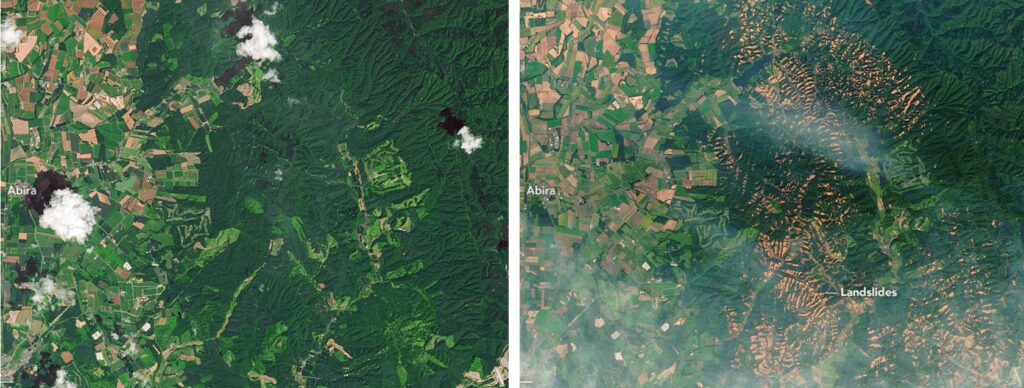
Media Attributions
- Figure 5.1.1 Steven Earle, CC BY 4.0
- Figure 5.1.2 Steven Earle, CC BY 4.0
- Figure 5.1.3 Photos by Steven Earle, CC BY 4.0
- Figure 5.1.4 Steven Earle, CC BY 4.0
- Figure 5.1.5 Photo from The Province newspaper, used with permission.
- Figure 5.1.6 Steven Earle, CC BY 4.0
- Figure 5.1.7 Public domain image from Dauphin, L. (2018). Landslides in Hikkaido. NASA Earth Observatory, https://earthobservatory.nasa.gov/images/92832/landslides-in-hokkaido
- Riverside Drive Landslide, from Natural hazards learning resources at EOAS, UBC, https://blogs.ubc.ca/eoashazards/riverside-drive-landslide/ ↵
